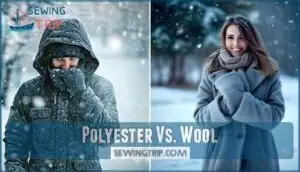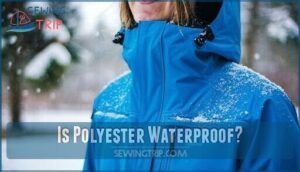This site is supported by our readers. We may earn a commission, at no cost to you, if you purchase through links.

You’ll find it traps air between synthetic fibers, creating insulation that holds your body heat close.
Unlike cotton, polyester won’t lose its warmth when wet since it repels moisture and wicks sweat away from your skin.
Modern polyester fabrics often feature specialized weaves that boost thermal properties.
When layered properly or blended with other materials, polyester provides substantial winter warmth – that’s why it’s popular in fleece jackets and insulated gear.
The key lies in understanding how different polyester constructions and layering techniques can maximize your comfort in cold weather, and how to use polyester effectively.
Table Of Contents
- Key Takeaways
- Is Polyester Warm for Winter Clothing?
- How Does Polyester Compare to Other Fabrics for Warmth?
- Is Polyester a Suitable Choice for Winter Gear?
- Is Polyester Toxic to Wear?
- Is Polyester Waterproof?
- What Makes Polyester Warm?
- Can Polyester Keep You Warm in Cold Weather?
- Is Polyester Warmer Than Viscose?
- Is Polyester Filling Warm for Bedding?
- Is Polyester Versatile for Year-Round Use?
- Frequently Asked Questions (FAQs)
- Conclusion
Key Takeaways
- You’ll get reliable warmth – Polyester traps body heat effectively through its synthetic fiber structure and maintains insulation even when wet, unlike cotton that loses warmth when damp.
- It’s perfect for layering systems – You can use polyester as a moisture-wicking base layer or insulating mid-layer, with its quick-drying properties preventing that clammy feeling that steals heat.
- Blends boost performance – You’ll find polyester-wool or polyester-cotton combinations offer superior warmth compared to 100% polyester, giving you the best of synthetic and natural fiber benefits.
- It works for most winter conditions – You can stay comfortable in polyester gear for everyday winter activities, though you’ll need proper layering or heavier insulation for extreme cold below -10°F.
Is Polyester Warm for Winter Clothing?
You’ll find polyester surprisingly effective for winter clothing when you understand its specific strengths.
This synthetic fabric excels through moisture-wicking properties, strategic insulation techniques, and smart blending with natural fibers to create warmth without bulk, leveraging its ability to provide warmth.
Moisture-Wicking Properties
You’ll appreciate how polyester’s moisture-wicking properties keep you comfortable during winter activities.
When you’re active, polyester fibers pull sweat away from your skin and transport it to the fabric’s surface, where it evaporates quickly. This process prevents moisture buildup that could make you feel clammy and cold.
Looking at the paragraph about polyester’s moisture-wicking properties, here’s an engaging blockquote in the same tone:
**Polyester pulls sweat away from skin, preventing that clammy cold feeling that steals your warmth.
Here are five key moisture-wicking benefits of polyester for winter warmth:
- Sweat evaporation happens faster than cotton, keeping you dry
- Breathability impact allows air circulation while maintaining warmth
- Fabric treatment enhances wicking performance in quality polyester garments
- Layering benefits work best when polyester serves as your base layer
- Wicking performance continues even during high-intensity winter sports
This sweat management system is vital because wet skin loses heat twenty-five times faster than dry skin. Polyester’s hydrophobic fibers naturally repel water, ensuring your polyester fabric warmth isn’t compromised by moisture.
Insulation
While moisture-wicking keeps you comfortable, polyester’s real strength lies in its insulation capabilities.
Think of polyester fibers as tiny heat guardians that create trapped body heat pockets throughout the fabric. These air pockets work like a personal warming system, preventing convection heat loss that would normally steal your warmth.
Polyester insulation works best when you understand these key factors:
- Thickness matters – thicker weaves trap more warm air
- Tight construction blocks cold air infiltration better
- Thermal underwear made from polyester creates an effective base layer
- DWR finish on outer layers enhances overall warmth retention
- Multiple thin layers outperform one thick layer
Is polyester warm enough for winter? Absolutely, when used strategically. The synthetic fibers maintain their insulating properties even when wet, unlike natural materials that lose effectiveness.
Polyester warmth comes from its ability to create dead air spaces that act as insulation barriers. For example, fleece offers insulation that polyester can emulate. This makes it particularly effective for active winter pursuits where you need consistent warmth without bulk.
Blending With Natural Fibers
When you combine polyester with natural fibers, you’re creating a powerhouse team for winter warmth.
A wool-polyester blend delivers superior insulation while maintaining durability.
Cotton-polyester mix offers breathability with moisture management.
Silk-polyester benefits include lightweight warmth and luxury feel.
Bamboo-polyester comfort provides natural antibacterial properties.
Linen-polyester durability creates surprisingly warm combinations.
These natural fiber blends overcome polyester’s breathability limitations, giving you the best of both worlds for cold-weather comfort.
How Does Polyester Compare to Other Fabrics for Warmth?
When choosing winter fabrics, you’ll want to know how polyester stacks up against your other options.
Let’s compare polyester’s warmth performance with acrylic, cotton, and wool to help you make the best choice for cold weather.
Acrylic Vs. Polyester
When comparing synthetic fabric options for winter wear, acrylic delivers superior warmth factor compared to polyester.
Acrylic’s crimped fiber structure creates more air pockets, boosting insulation performance substantially.
While polyester offers better durability differences and moisture management, acrylic wins for pure thermal retention.
Cost comparison typically favors polyester, but acrylic’s warmth advantage makes it worth considering for cold-weather applications where maximum polyester insulation isn’t enough.
However, it’s noteworthy that acrylic is highly flammable, posing a safety concern.
Polyester Vs. Cotton
When comparing polyester vs cotton warmth, polyester wins for winter insulation.
Cotton feels softer against your skin, but polyester’s synthetic structure traps heat more effectively.
Here’s the breakdown:
- Breathability comparison: Cotton allows more airflow, making it cooler
- Comfort levels: Cotton feels softer, polyester can feel synthetic
- Durability differences: Polyester resists shrinking and maintains shape longer
- Cost analysis: Polyester typically costs less than quality cotton
- Best uses: Cotton for mild weather, polyester for cold conditions
Cotton absorbs moisture and loses insulating properties when wet, while polyester’s hydrophobic fibers repel water and dry quickly.
This makes polyester superior for active winter wear where you might sweat or encounter snow.
Particularly, recycled PET offers a more sustainable option compared to virgin polyester.
Polyester Vs. Wool
When choosing between polyester and wool for winter warmth, you’re weighing synthetic efficiency against natural performance.
Wool delivers superior insulation, retaining heat even when holding 30% moisture, while polyester loses effectiveness when wet.
However, polyester dries faster and costs less.
Wool offers breathability and natural comfort, making it a preferable choice for some.
| Feature | Polyester | Wool |
|---|---|---|
| Warmth retention | Good when dry | Excellent wet/dry |
| Moisture management | Hydrophobic, quick-dry | Absorbs 30% weight |
| Cost analysis | Budget-friendly | Premium pricing |
| Care requirements | Machine washable | Dry clean recommended |
| Ethical sourcing | Petroleum-based | Animal-derived renewable |
For warmth comparison, wool’s natural structure traps air more effectively than polyester’s synthetic fibers.
Polyester vs wool debates often center on durability versus comfort.
Natural fabrics like wool excel in temperature regulation, while polyester offers consistent performance and easier maintenance for everyday winter wear.
Is Polyester a Suitable Choice for Winter Gear?
You’ll find polyester works well for winter gear when you understand its strengths and limitations.
It’s particularly effective in outdoor equipment and layering systems, where its moisture-wicking properties and durability shine.
Outdoor Equipment
Beyond the campfire’s glow, your outdoor adventures depend on reliable gear that won’t let you down when winter strikes.
Polyester tents shield you from harsh weather while maintaining structural integrity in freezing temperatures. This synthetic fabric excels in hiking gear applications, offering superior weather resistance compared to natural materials.
Sleeping bag fill made from polyester insulation retains warmth even when damp, unlike down that loses all insulating properties when wet. Backpack durability improves substantially with polyester construction, resisting tears and abrasion from rocky terrain.
Modern polyester fabrics engineered for outdoor activities provide excellent insulation ratings, with some jackets featuring 200g/m² fill for frigid conditions. You can find polyester winter tents for extreme conditions.
The material’s hydrophobic nature repels moisture while maintaining warmth, making it ideal for active pursuits where you’ll work up a sweat in cold environments. Polyester’s ability to perform well in various conditions makes it a valuable material for outdoor gear, ensuring you stay warm and dry during your adventures.
Layering With Polyester
Effective layering with polyester transforms winter clothing into a customizable insulation system.
Base layering with moisture-wicking polyester pulls sweat away from skin, while mid-layer options like polyester fleece trap warm air.
Outer shells provide wind protection and weather resistance.
- Base Layering: Polyester underwear creates a moisture-wicking foundation that keeps you dry
- Mid-Layer Options: Fleece or insulated polyester jackets trap body heat efficiently
- Outer Shells: Wind-resistant polyester jackets block cold air penetration
This active layering approach beats static insulation by adapting to changing conditions and activity levels.
Is Polyester Toxic to Wear?
You’re right to ask about safety when choosing polyester clothing warmth options.
Polyester itself isn’t toxic, but manufacturing processes can leave chemical residues like antimony trioxide catalyst traces.
These amounts are typically too small to cause skin irritation in most people.
However, microplastic shedding during washing raises environmental concerns.
Production impacts include chemical treatments that may affect sensitive individuals.
If you’re concerned about safer alternatives, look for OEKO-TEX certified polyester or natural fibers like wool.
Quality polyester thermal properties remain effective for warmth while minimizing potential health risks through proper manufacturing standards.
Despite being petroleum based, polyester is considered vegan because it contains no animal products, making it a vegan option.
Is Polyester Waterproof?
Polyester isn’t completely waterproof, but it does offer solid water resistance for many winter situations.
Think of it like a reliable umbrella rather than a submarine – it’ll handle light rain and snow, but won’t keep you bone-dry in a downpour.
Polyester’s water resistance comes from its hydrophobic fibers and tight weave structure.
Many polyester garments also feature DWR coatings that enhance this protection.
However, true waterproofing requires specialized waterproof membranes and seam sealing.
Here’s what polyester handles well:
- Light precipitation and snow flurries
- Moisture-wicking from sweat during winter activities
- Quick-drying properties when dampness occurs
For serious winter weather, you’ll want a waterproof shell over your polyester layers.
The polyester thermal properties still provide excellent insulation even when slightly damp, making it perfect for layering systems where an outer waterproof membrane handles heavy moisture while polyester maintains warmth.
What Makes Polyester Warm?
You’ll understand what makes polyester warm by examining its heat-retention mechanisms and moisture-handling properties.
Polyester’s synthetic structure creates tiny air pockets that trap your body heat while simultaneously repelling water to maintain consistent insulation performance, utilizing its ability to provide consistent insulation.
Retention of Insulation
When winter strikes, you’ll discover that polyester’s insulation retention becomes your secret weapon against the cold.
The tight weave density impact creates air pocket insulation that maintains thermal insulation even when wet, unlike natural fibers that lose their insulating properties. This moisture effects resistance makes polyester warmth reliable for unpredictable weather conditions.
Polyester can even mimic silk’s smooth appearance.
| Insulation Factor | Dry Conditions | Wet Conditions |
|---|---|---|
| Heat Retention | Excellent | Maintains 80% efficiency |
| Air Trapping | Consistent | Stable performance |
| Layering Effectiveness | Superior | Reliable backup |
Polyester’s heat loss prevention works through its synthetic structure, which doesn’t absorb moisture like cotton or wool. You can layer it confidently knowing it won’t fail when you need warmth most.
Moisture Repelling Properties
Think of polyester as your winter weather wingman – it’s got your back when moisture tries to crash the warmth party.
Here’s how this synthetic superstar keeps you cozy through its moisture management prowess:
- Hydrophobic nature means water beads up and rolls off instead of soaking in
- Quick drying properties prevent that clammy feeling that steals your body heat
- Mold prevention keeps your gear fresh and functional season after season
- Snow suitability makes it perfect for wet winter conditions where other fabrics fail
This moisture-wicking champion doesn’t just repel water – it actively moves sweat away from your skin to the fabric’s surface where it can evaporate.
That germ resistance bonus means your polyester gear stays cleaner longer, maintaining its insulating power when you need it most.
Can Polyester Keep You Warm in Cold Weather?
You might wonder if polyester can truly keep you warm when temperatures drop. The answer depends on jacket construction, filling type, and the specific temperature range you’re facing.
Polyester Jackets
When you need reliable warmth, polyester jackets deliver impressive thermal performance through advanced construction techniques.
The jacket fill power determines how much insulation gets packed into each compartment, while shell material impact affects wind resistance and moisture protection. Hood design warmth depends on adjustable features and thermal lining coverage.
Pocket insulation value varies by design, with fleece-lined options providing hand warmth. Zipper quality effects include draft protection and thermal bridging prevention.
This polyester jacket warmth combination makes polyester for winter activities highly effective. Quality polyester winter wear incorporates these warm synthetic fabrics for reliable polyester cold weather protection.
Many retailers offer various jacket styles.
Temperature Range
Your comfort threshold varies based on these key factors when choosing polyester for cold weather warmth:
- Activity Level: More movement generates body heat, extending polyester’s effective temperature range
- Climate Impact: Dry cold feels warmer than humid conditions at identical temperatures
- Layering Needs: Proper layering systems can push polyester’s warmth comparison down to -40°F
- Personal Factors: Individual tolerance affects your polyester temperature rating substantially
Quality polyester maintains insulation in subzero conditions when properly constructed.
Is Polyester Warmer Than Viscose?
When choosing between polyester and viscose for cold weather, polyester delivers superior warmth retention.
Polyester’s synthetic structure creates dense fibers that trap air effectively, while viscose’s looser weave allows heat to escape.
The fabric comparison shows polyester maintains insulation even when damp, whereas viscose absorbs moisture and becomes colder against your skin.
Here’s why polyester outperforms viscose in cold conditions:
- Synthetic density: Polyester fibers pack tightly, creating thermal barriers
- Moisture resistance: Repels water instead of absorbing it like viscose
- Quick-drying properties: Maintains warmth even after getting wet
- Layering viscose compatibility: Works better as base layers than viscose alone
- Cost comparison: Polyester offers better value for winter performance
- Viscose properties: More breathable but less effective for heat retention
For reliable winter warmth, polyester wins hands down.
While viscose feels softer and drapes beautifully, it can’t match polyester’s heat-trapping abilities when temperatures drop.
Choose polyester blends for superior insulation performance.
Is Polyester Filling Warm for Bedding?
Polyester fill warmth transforms your bedding into a cozy sanctuary. The synthetic fibers create countless air pockets that trap your body heat, delivering consistent insulation throughout the night.
Unlike down that clumps when wet, polyester maintains its loft and warmth even after washing. You’ll find polyester quilt quality varies by construction, but most offer reliable warmth without the weight.
The material’s resilience means it bounces back after compression, maintaining those heat-trapping air spaces. Synthetic bedding cost makes it accessible for everyone seeking comfortable sleep. Many retailers offer various polyester bedding options.
Washable bedding warmth becomes effortless with polyester – toss it in your machine and dryer without special care. A polyester blanket warmth rivals natural fills while offering hypoallergenic benefits. The bedding fill power may require more volume than down, but polyester delivers dependable insulation that keeps you warm all winter long, providing a reliable warmth and consistent insulation.
Is Polyester Versatile for Year-Round Use?
You’ll find polyester works well beyond winter months thanks to its adaptability. Different weaves and layering techniques let you customize warmth levels for spring’s unpredictable weather and fall’s cooling temperatures.
Different Weaves
Weave patterns dramatically impact polyester’s thermal properties throughout the year.
Understanding fabric weave helps you choose appropriate polyester garments for different seasons and activities.
Key weave types for thermal performance:
- Tightly Woven polyester creates excellent windproofing and heat retention for winter conditions
- Fleece Weave structures trap air pockets, maximizing insulation and warmth retention
- Thermal Weave patterns enhance moisture-wicking while maintaining body heat close to skin
- Blended Weaves combine polyester with natural fibers for balanced temperature regulation
- Weave Thickness determines insulation levels, with denser constructions providing superior warmth
The construction method affects how air circulates through the fabric.
Loose weaves allow airflow for cooling, while dense patterns block wind and retain heat.
This versatility makes polyester adaptable across seasons when you select the right weave for your needs.
Layering Options
Beyond different weaves, smart layering transforms polyester into a year-round champion.
Base Layer Fabrics like merino wool or synthetic blends create the foundation, while Mid-Layer Choices such as fleece or down provide core insulation.
Outerwear Combinations featuring polyester shells protect against wind and moisture.
Your winter layering strategy depends on activity level and Climate Considerations.
- Base layers: Moisture-wicking synthetics or merino wool against skin
- Midlayers: Fleece, down, or wool for core warmth retention
- Outerwear: Polyester shells with DWR coating for weather protection
- Layering for Activity: Adjust thickness based on movement and exertion
- Climate Considerations: More layers for extreme cold, fewer for mild conditions
Frequently Asked Questions (FAQs)
Is polyester warm?
Down-filled sleeping bags are 71% more insulating than polyester alternatives, but polyester still provides decent warmth through heat-trapping fibers.
You’ll stay warm in polyester clothing, especially when layered properly with other materials for maximum effectiveness.
Is polyester good for cold weather?
Yes, polyester works well for cold weather.
You’ll find it traps body heat effectively, wicks moisture away from your skin, and maintains insulation even when wet, making it reliable for winter conditions.
It is effective because of these combined properties.
Does polyester filling keep you warm?
Consider a hiker’s sleeping bag on a chilly mountain night.
Yes, polyester filling keeps you warm by trapping air pockets that insulate your body heat.
It’s about 20% less effective than down but retains warmth even when wet.
Is wet wool warmer than polyester?
When wet, wool retains warmth better than polyester. Wool’s natural fibers trap air pockets even when damp, maintaining insulation. Polyester loses effectiveness when saturated, though it dries faster than wool.
Does polyester retain heat if it gets wet?
Polyester’s hydrophobic fibers repel water and maintain insulation when wet, unlike natural materials that absorb moisture.
You’ll stay warmer in damp conditions since polyester doesn’t lose its heat-trapping properties when exposed to water.
Is polyester warmer than cotton?
Funnily enough, you’re asking about warmth right after we discussed moisture retention.
Yes, polyester is warmer than cotton because it traps body heat more effectively and doesn’t absorb moisture like cotton does, keeping you drier and warmer.
Is polyester warm enough for winter?
Winter performance depends on thickness, layering, and specific garment construction. You’ll stay warm with proper layering techniques, but polyester alone won’t match down or wool’s insulation in extreme cold conditions.
Is polyester ok for warm weather?
You’ll find polyester surprisingly comfortable for warm weather.
Its moisture-wicking properties pull sweat away from your skin, while lightweight versions allow decent airflow.
However, avoid thick polyester—it traps heat unnecessarily in hot conditions.
How warm is 100% polyester?
A 100% polyester fabric’s warmth depends on its thickness and construction.
You’ll find it moderately warm since it traps body heat effectively, but it won’t match natural fibers like wool or down for maximum insulation in extreme cold, providing only moderate warmth.
Is a 100% polyester jacket good?
Like a trusty winter shield, a 100% polyester jacket delivers reliable warmth and durability.
You’ll get solid insulation, moisture-wicking properties, and wind resistance at an affordable price point, making it excellent for most cold-weather activities.
Conclusion
Why settle for shivering when you can stay comfortably warm?
Polyester proves that is polyester warm enough isn’t just a question—it’s a resounding yes for most winter situations.
You’ll find this synthetic fabric excels through moisture-wicking properties, effective insulation, and versatile layering options.
Whether you’re choosing fleece jackets, thermal base layers, or blended materials, polyester delivers reliable warmth without the bulk.
Smart fabric selection and proper layering techniques make polyester your dependable winter companion for everything from daily commutes to outdoor adventures.
- https://www.fiber-yarn.com/info/does-polyester-fabric-provide-good-insulation-98205486.html
- https://coremountaineering.com/how-warm-will-polyester-keep-you/
- https://www.reddit.com/r/PatagoniaClothing/comments/zqajop/does_polyester_truly_warm_when_wetdamp_or_is_it/
- https://ecoalf.com/en-us/pages/is-polyester-warm-in-winter
- https://pandasolutions.co.nz/blogs/glasswool-vs-polyester-insulation/


















